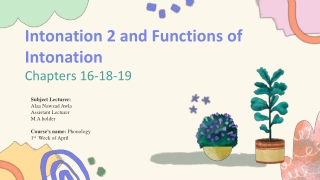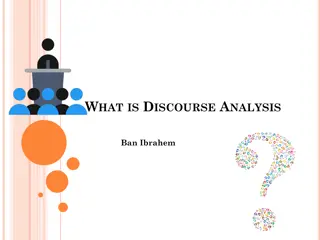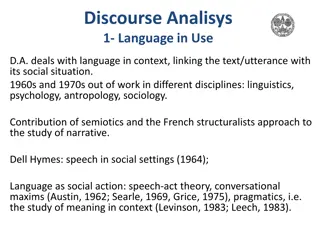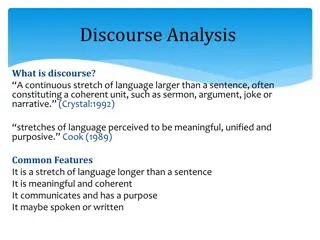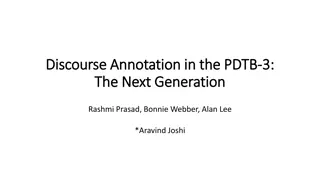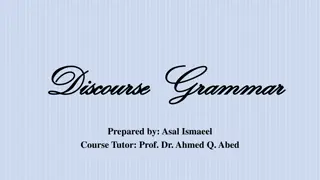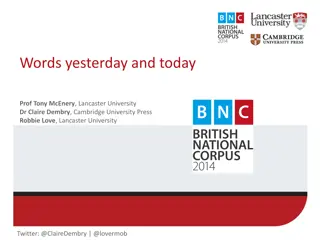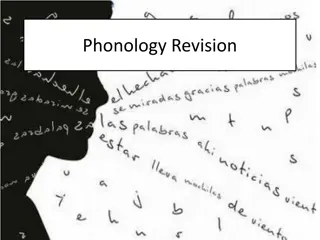Understanding Discourse Intonation in English Language Teaching
Discourse Intonation (DI) in English language teaching focuses on the significance of intonation in conveying meaning within spoken discourse. It involves key components such as prominence, tone, key, and termination. DI can help students and teachers by providing a framework for analyzing intonation, improving listening skills, and enhancing oral performance. While DI may be complex to teach due to transcription notations, solutions suggest gradually raising awareness and integrating it into classroom activities. Practical ideas include using exercises, avoiding tedious methods, and focusing on consciousness-raising and speaking activities.
Download Presentation

Please find below an Image/Link to download the presentation.
The content on the website is provided AS IS for your information and personal use only. It may not be sold, licensed, or shared on other websites without obtaining consent from the author. Download presentation by click this link. If you encounter any issues during the download, it is possible that the publisher has removed the file from their server.
E N D
Presentation Transcript
BALEAP WEBINAR - Pronunciation Using Discourse Intonation with EAP Students Richard Cowen Richcowen2@gmail.com
What is Discourse Intonation? (DI) The significance of intonation is related to the function of the utterance as an existentially appropriate contribution to an interactive discourse (Brazil 1984:46). By making a choice in any of the intonation systems a speaker makes some kind of assumption about what he/she takes, for present purposes, to be the state of understanding between him/her and a hearer (Brazil 1997:132). References: Brazil, D: Pronunciation for Advanced Learners of English 1994 CUP
The key components of DI PROMINENCE: changes in stress, pitch or emphasis for added meaning to be inferred in spoken language. The tonic syllable: prominent syllable in the tone unit TONE: falling, rising, rise-fall, Fall-rise, Level> dependent on proclaiming and referring function of utterance. KEY: High key (contrary to expectations), Mid Key (additive) , Low Key (as expected) TERMINATION: The choices speakers make beforehand considering the above.
How can it help students and teachers? Provides a consistent framework for analysing intonation. By raising awareness of the importance of intonation it s not only about WHAT we say, but HOW! Facilitates understanding > receptive. A more holistic and top-down approach to improving listening skills. Accentuates the need for modulation in speech > improved oral performance.
Problems and Difficulties with DI It s complicated! Eg: use of transcription notation rise, fall, rise-fall, fall-rise, level Is it teachable? How useful is it for students? Time constraints.
Solutions Complications?: spend some time giving clear guidelines and examples. Teachability?: a little but often > gradually raise awareness of what DI is. Usefulness?: teacher needs to identify most useful elements and focus accordingly. Time constraints?: don t make it a separate issue in the classroom > integrate it.
Some practical ideas See Underhill exercises/activities Avoid using Brazil s transcription method sts will find this tedious Use recording script teacher identifies salient features and practises with sts. Focus on consciousness-raising activities. Integrate into speaking activities. Remember that intonation is context sensitive. Sts need plenty of exposure.
DI in action referring and proclaiming From Underhill (88-9): Alice referring tone Alice referring + tone Alice proclaiming tone Alice proclaiming + tone These activities can be FUN to practise in class!
DI in Action 1. | The TEA S | on the TABle 2. | The TEA S | on the TABle Sentence one: referring + proclaiming tone. Sentence two: proclaiming + referring tone.
Recommendations/suggestions Exploit transcripts to raise awareness of DI. EG: sts identify whch key the lecturer is talking in: high, medium or low? Presentation skills get sts to practise intonation avoid obsession with content sts need to focus on HOW they delivery their message DI can play an important role. Integrate a focus on intonation in the classroom. Make it an integral part of listening and speaking skills classes Encourage personalisation the tone we use is often determined by our reaction to what we hear avoid the regular course book straitjacket. Avoid technicalities as much as possible associated with DI. Rather, focus on how you can directly help sts develop their listening skills through a practical application of DI, possibly by exploiting transcripts.
References References: Brazil, D: Pronunciation for Advanced Learners of English 1994 CUP Underhill, A: Sound Foundations 2000 Macmillan Heinemann Hadley, G.S. A Discourse approach to Intonation http://nuis.ac.jp Speech in Action


